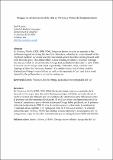Files in this item
Ortega y la reivindicación de la vida en Viviana y Merlín, de Benjamín Jarnés
Item metadata
| dc.contributor.author | Larios, Jordi | |
| dc.date.accessioned | 2022-04-18T23:42:18Z | |
| dc.date.available | 2022-04-18T23:42:18Z | |
| dc.date.issued | 2020-10-19 | |
| dc.identifier | 266074371 | |
| dc.identifier | cfaf6a69-2e1b-4260-b8d0-397d4359a0e7 | |
| dc.identifier | 85092934547 | |
| dc.identifier | 000581859400003 | |
| dc.identifier.citation | Larios , J 2020 , ' Ortega y la reivindicación de la vida en Viviana y Merlín , de Benjamín Jarnés ' , Hispanic Research Journal , vol. 20 , no. 6 , pp. 566-582 . https://doi.org/10.1080/14682737.2019.1787614 | en |
| dc.identifier.issn | 1468-2737 | |
| dc.identifier.other | ORCID: /0000-0002-8181-2419/work/83481909 | |
| dc.identifier.uri | https://hdl.handle.net/10023/25205 | |
| dc.description.abstract | In Viviana y Merlín (1929, 1930, 1936), Benjamín Jarnés recycles an episode of the Arthurian legend involving the two title characters, whereby he avails himself of the ‘mythical method’ so widely used by modernist writers to reflect on the present with tools from the past. This article offers a close reading of Jarnés’s ’leyenda’ through the lens provided by three texts that Ortega had published in the early to mid- 1920s: El tema de nuestro tiempo and, most importantly, ‘Vitalidad, alma, espíritu’ and ‘Epílogo al libro De Francesca a Beatrice’. The article shows that Viviana y Merlín fictionalizes Ortega’s raciovitalismo as well as his topografía del ‘yo’, and it is a work tainted by the philosopher’s proverbial misogyny. | |
| dc.format.extent | 437887 | |
| dc.language.iso | spa | |
| dc.relation.ispartof | Hispanic Research Journal | en |
| dc.subject | Jarnés | en |
| dc.subject | Viviana y Merlín | en |
| dc.subject | Ortega | en |
| dc.subject | Raciovitalismo | en |
| dc.subject | Topografía del ‘yo’ | en |
| dc.subject | P Language and Literature | en |
| dc.subject | I | en |
| dc.subject | BDC | en |
| dc.subject | R2C | en |
| dc.subject | SDG 5 - Gender Equality | en |
| dc.subject.lcc | P | en |
| dc.title | Ortega y la reivindicación de la vida en Viviana y Merlín, de Benjamín Jarnés | en |
| dc.title.alternative | Ortega and the celebration of life in Benjamín Jarnés's Viviana y Merlín | en |
| dc.type | Journal article | en |
| dc.contributor.institution | University of St Andrews. Centre for Poetic Innovation | en |
| dc.contributor.institution | University of St Andrews. Spanish | en |
| dc.identifier.doi | 10.1080/14682737.2019.1787614 | |
| dc.description.status | Peer reviewed | en |
| dc.date.embargoedUntil | 2022-04-19 |
This item appears in the following Collection(s)
Items in the St Andrews Research Repository are protected by copyright, with all rights reserved, unless otherwise indicated.

